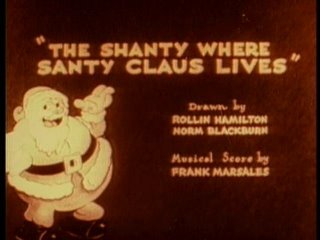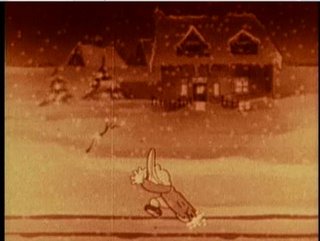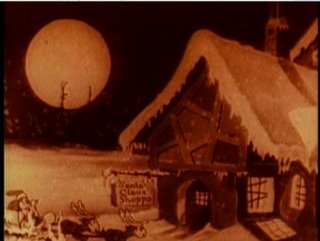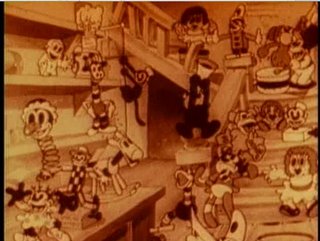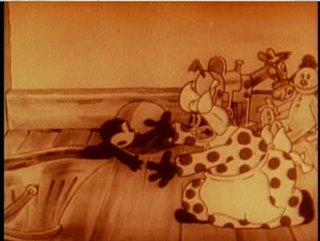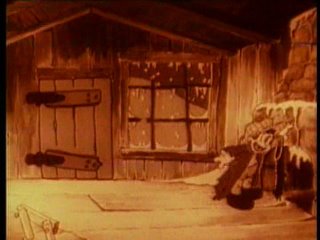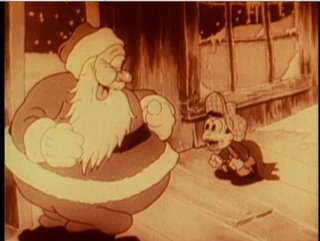
So, here we have Trolley Troubles, the debut Oswald the Lucky Rabbit cartoon (at least the first to show; supposedly a cartoon called Poor Papa was made and rejected; this is the first extant example, and can be found on the Disney Treasures Oswald collection). This is the face that launched a thousand ships?
Love:
The running trolley. This is literal; it's trying to use its wheels like feet.

The trolley widening to the fit the tracks. And thinnening to also fit the tracks. And it's in an animated background coming-at-the-camera shot. Too bad it repeats jokes within its tedious length several times.


Nose thumbing.

Goat ramming.


Butt waggling
Nice animated hills. The grey gives it a real mass and 3D feel the characters lack. The trolley has a good feel too, as it tosses the ugly little passengers off.

Under car shot

Vicious rabbits foot

The Oswald ass end.

Hate: Incredibly irritating music (courtesy of Robert Israel and the Robert Israel Orchestra). To be fair, this is not the fault of the original cartoon itself, but of the "restoration". It's also easily remedied by turning off the volume. I wonder why people scoring silents mostly use the same incredibly boring sound. This score is even using multiple instruments; if it was just a piano or an organ, I could maybe forgive it. But to use a form of instrumentation that would only have been used in the grandest of presentations, in a tiny handful of luxury theatres? You may as well go whole hog, ignore the sounds of the era, and make something good instead.
(For an example of one of those rare showings, see
http://www.cartoonbrew.com/disney/colony-theatre-92427 )
Incredibly repetitive animation. The opening scene repeats the same animation of kids catapulting off part of a trolley 6 times.

Repetitive design: those kids above are all the same rabbit.
The next shot repeats a cycle of kids climbing up the side of a trolley and going off to the left (down across a window where it is never seen), then another kid climbing up and going off to the right, ten times. Not 5 for each direction. 10 times for each direction (actually 9; the last going right is absent). Now, to be fair, Oswald himself is oiling the trolley's troll-hole, and some unlucky rabbit's face. But this ugly repetition is in service to the idea that if everything is always moving, that's good (enough). (The weird mutilated wheels on the trolley are interesting tho).

The overall awful ruralness of it all. Would there have been trolleys for bumpkins? My impression is the Toonerville Trolley (which had been a strip for almost 20 years before this short and had had something like 17 shorts made 5 years earlier than this short; gosh, I wonder where they got the idea for Trolley Troubles?) was similarly horribly rural, but I haven't seen any of Toonerville since watching the Oswald shorts.
Repetitive tunnel shots, even if the silhouette is cool.

I'm not sure exactly how this gave Winkler faith in the Oswald series's potential popularity. But then its only the silents that have made their way to me filtered through 80 years of letting bad cartoons slip into nitrate film stock non-existence, and the rise (and fall) of the theatrical short generally and the Oswald series itself more specifically giving me better material to compare it to. Look at the post preceding this; the brand in 40 years would retain rabbits and overalls, but would be otherwise unrecognizable. Oswald would go through several unrecognizable changes, and would essentially be dead on screen in only 11 years.









